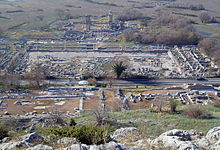
Back Филипи Bulgarian Arheološko nalazište Filipi BS Filipos Catalan Fílippoi (arkiyolohiyang dapit) CEB Filippoi (antické město) Czech Philippi Welsh Filippi Danish Philippi German Φίλιπποι Greek Filipio Esperanto
Φίλιπποι | |
 Ruins of the centre of the city. The forum in the foreground, the market and the Basilica in the background. | |
| Location | Filippoi, Eastern Macedonia and Thrace Greece |
|---|---|
| Region | Macedonia |
| Coordinates | 41°00′47″N 24°17′11″E / 41.01306°N 24.28639°E |
| Type | Settlement |
| History | |
| Founded | 356 BC |
| Abandoned | 14th century |
| Site notes | |
| Official name | Archaeological Site of Philippi |
| Criteria | Cultural: iii, iv |
| Reference | 1517 |
| Inscription | 2016 (40th Session) |
| Area | 87.545 ha |
| Buffer zone | 176.291 ha |
Philippi (/fɪˈlɪpaɪ, ˈfɪləˌpaɪ/; Ancient Greek: Φίλιπποι, Phílippoi) was a major Greek city northwest of the nearby island, Thasos. Its original name was Crenides (Ancient Greek: Κρηνῖδες, Krēnĩdes "Fountains")[1] after its establishment by Thasian colonists in 360/359 BC. The city was renamed by Philip II of Macedon in 356 BC and abandoned in the 14th century after the Ottoman conquest. The present village of Filippoi is located near the ruins of the ancient city and is part of the region of East Macedonia and Thrace in Kavala, Greece. The archaeological site was classified as a UNESCO World Heritage Site in 2016 because of its exceptional Roman architecture, its urban layout as a smaller reflection of Rome itself, and its importance in early Christianity.[2]
- ^ Bourchier, James David (1911). . In Chisholm, Hugh (ed.). Encyclopædia Britannica. Vol. 21 (11th ed.). Cambridge University Press. p. 390.
- ^ "Archaeological Site of Philippi". World Heritage Convention. United Nations Educational Scientific and Cultural Organization. Retrieved 10 December 2022.
